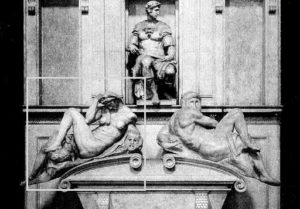
Until about 2004, photography using light fields was possible but impractical.
Image: llustrations from The Life of Michael Angelo by Romain Rolland, translated by Frederic Lees: Tomb of Giuliano de’ Medici with Night and Day; attribution: “Life of Michael Angelo, 1912 – Tomb of Giulino de Medici” by Michelangelo Buonarroti – Details.
To appreciate that “light field” photography’s becoming practical and inexpensive has basically launched a new era in every field related to photographic imaging, whether medical, educational, scientific, or artistic, it is necessary to appreciate how recent these developments really are.
Consider, for example, the 1999 undertaking to achieve a light field digital image of a statue, by Marc Levoy and Jonathan Shade, from Stanford University’s Computer Graphics Laboratory. In a blog describing their project to digitize the Michelangelo statue, “Night,” in Italy, by photographing the statue from vantage points of its various light fields, they wrote:
A light field can be thought of as an array of perspective images of a scene taken from viewpoints spaced closely together on a 2D plane. If the spacing between the viewpoints is sufficiently dense, and the views themselves are sufficiently wide-angle, then the array contains within it a measurement of the light leaving every point in the scene and traveling in every direction, literally the field of light surrounding the scene. By extracting pixels from these images – sometimes only a few pixels from each, it is possible to construct correct perspective images for viewpoints other than those present in the original array.
To really appreciate the new light field technology, it is worthwhile to review the details of their meticulous and slow process, and, in particular, a diagram of a circular light field simplifying the points-of-light input points, in their Michelangelo light field project article.
Despite the concept of light field photography being known for 100 years, according to Wikipedia, it was not until 2004 that Stanford University’s Computer Graphics Laboratory proved that, using plenoptics to photograph many light fields surrounding a subject, and rendering the many pictures into a single image, digital pictures could be refocused after they are taken.
Source for the above: Wikipedia.
To see the components of the light field computational photography process, please visit the next page.



